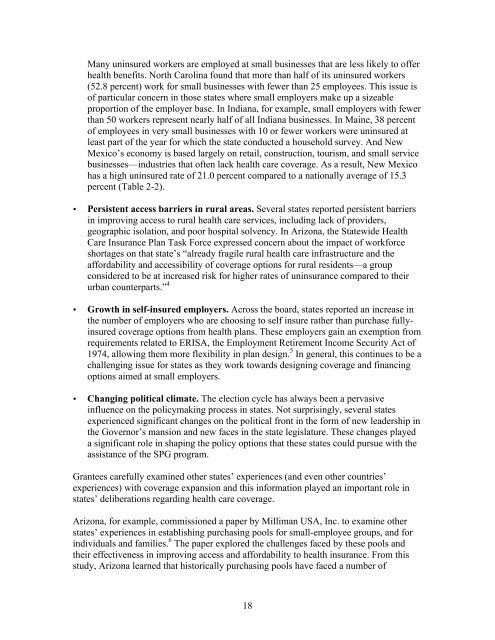SPG synthesis report - State Coverage Initiatives
SPG synthesis report - State Coverage Initiatives
SPG synthesis report - State Coverage Initiatives
You also want an ePaper? Increase the reach of your titles
YUMPU automatically turns print PDFs into web optimized ePapers that Google loves.
Many uninsured workers are employed at small businesses that are less likely to offer<br />
health benefits. North Carolina found that more than half of its uninsured workers<br />
(52.8 percent) work for small businesses with fewer than 25 employees. This issue is<br />
of particular concern in those states where small employers make up a sizeable<br />
proportion of the employer base. In Indiana, for example, small employers with fewer<br />
than 50 workers represent nearly half of all Indiana businesses. In Maine, 38 percent<br />
of employees in very small businesses with 10 or fewer workers were uninsured at<br />
least part of the year for which the state conducted a household survey. And New<br />
Mexico’s economy is based largely on retail, construction, tourism, and small service<br />
businesses—industries that often lack health care coverage. As a result, New Mexico<br />
has a high uninsured rate of 21.0 percent compared to a nationally average of 15.3<br />
percent (Table 2-2).<br />
• Persistent access barriers in rural areas. Several states <strong>report</strong>ed persistent barriers<br />
in improving access to rural health care services, including lack of providers,<br />
geographic isolation, and poor hospital solvency. In Arizona, the <strong>State</strong>wide Health<br />
Care Insurance Plan Task Force expressed concern about the impact of workforce<br />
shortages on that state’s “already fragile rural health care infrastructure and the<br />
affordability and accessibility of coverage options for rural residents—a group<br />
considered to be at increased risk for higher rates of uninsurance compared to their<br />
urban counterparts.” 4<br />
• Growth in self-insured employers. Across the board, states <strong>report</strong>ed an increase in<br />
the number of employers who are choosing to self insure rather than purchase fullyinsured<br />
coverage options from health plans. These employers gain an exemption from<br />
requirements related to ERISA, the Employment Retirement Income Security Act of<br />
1974, allowing them more flexibility in plan design. 5 In general, this continues to be a<br />
challenging issue for states as they work towards designing coverage and financing<br />
options aimed at small employers.<br />
• Changing political climate. The election cycle has always been a pervasive<br />
influence on the policymaking process in states. Not surprisingly, several states<br />
experienced significant changes on the political front in the form of new leadership in<br />
the Governor’s mansion and new faces in the state legislature. These changes played<br />
a significant role in shaping the policy options that these states could pursue with the<br />
assistance of the <strong>SPG</strong> program.<br />
Grantees carefully examined other states’ experiences (and even other countries’<br />
experiences) with coverage expansion and this information played an important role in<br />
states’ deliberations regarding health care coverage.<br />
Arizona, for example, commissioned a paper by Milliman USA, Inc. to examine other<br />
states’ experiences in establishing purchasing pools for small-employee groups, and for<br />
individuals and families. 6 The paper explored the challenges faced by these pools and<br />
their effectiveness in improving access and affordability to health insurance. From this<br />
study, Arizona learned that historically purchasing pools have faced a number of<br />
18






